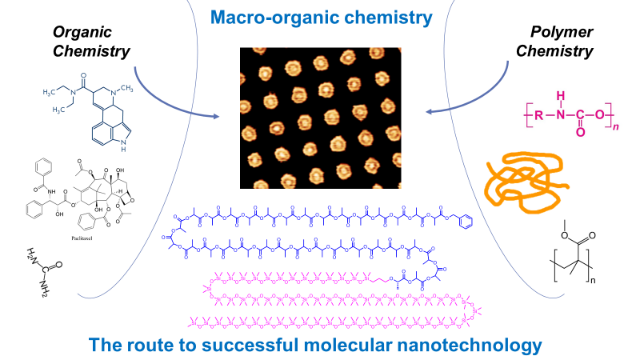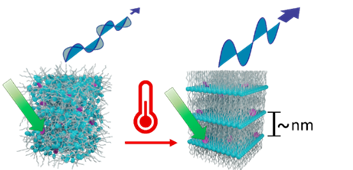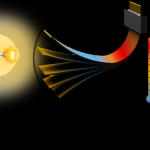Novel self-assembled polymer materials are needed to create a paradigm shift in electronic materials, nanolithographic applications, and responsive materials. In contrast to commonly used approaches in this field, we focus on polymeric materials that are perfectly defined at the molecular level. The advantage of this approach is that molecular structures can be directly related to macromolecular properties. The nature of the envisaged application determines which (combination of) molecular designs will be applied.

Synthesis of discrete and chiral molecular building blocks and their assembly
We explore different organic approaches to make nanomaterials with highly ordered, one- or two-dimensional molecular morphologies with domain sizes <10 nm. We have called this the macro-organic chemistry approach; where the beauty of organic chemistry is combined with the functionality of macromolecules and macroscopic systems. These molecules are based on oligomers of discrete length; for example, oligodimethylsiloxanes (oDMS) or oligo-alkenes. By modifying these oligomers with functional units, we get interesting phase-segregated block molecules that are somewhere in-between liquid crystals and block-copolymers. When the other blocks possess interesting properties, we aim at making the next generation of thin transistors. Processing conditions are compatible with the current infrastructure of the microelectronics industry, demonstrating commercial relevance.

Materials using chiral-induced spin selection
The Chiral Induced Spin Selection (CISS) effect relates to how electrons travel through a chiral environment. When electrons pass chiral assemblies, one spin state is preferred over the other. We study this phenomenon together with the group of Ron Naaman at the Weizmann Institute in Israel to arrive at the most ideal chiral architectures. A real challenge is now to use this CISS effect in spin-controlled chemical reaction. Currently we explore a supramolecular multi-step approach to prepare chiral electrodes and use the CISS effect to increase the efficiency of hydrogen production through water splitting and to synthesize chiral polymers.

Supramolecular materials with novel opto-electronic functions
We learn how to design assembled structures in which intermolecular interactions maximize charge transport and avoid exciton recombination. This type of materials combines phase-segregated structures with electronic and ionic functions to provide well-organized 1D and 2D channels capable of electrons and ions transport. These soft and stable materials are key for applications in energy conversion, transport and storage. Moreover, fascinating optical properties are obtained in close collaboration with the group of Prof. Jaime Goméz Rivas of our university, where we are able to create large domain materials that emit linearly polarized triplet-triplet annihilation.

New concepts
As supramolecular materials are thought to be crucial for an economy with cyclic materials use, we explore novel concepts where excellent polymer properties are combined with dynamic supramolecular interactions. Recently, we are highly interested in using multiple supramolecular interactions in polymer materials to create systems that are interesting for an easy bonding and debonding. With this approach, we tackle the issue of plastic recycling and like to address some fundamental questions on dynamic behavior of polymer chains In addition, we synthesize and explore novel materials for macroscopic motion of well-ordered materials for the development of soft robotics.

Pdf: Research project for master students